- Clinical Technology
- Adult Immunization
- Hepatology
- Pediatric Immunization
- Screening
- Psychiatry
- Allergy
- Women's Health
- Cardiology
- Pediatrics
- Dermatology
- Endocrinology
- Pain Management
- Gastroenterology
- Infectious Disease
- Obesity Medicine
- Rheumatology
- Nephrology
- Neurology
- Pulmonology
Chilblains and Pseudoporphyria
Dermclinic
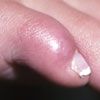
Figure 1
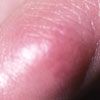
Figure 2
Case 1:
A 16-year-old girl reports that during the winter the skin on her toes becomes painful for several hours at a time. She has had these episodes for 2 years but is otherwise healthy.
Which of the following would you include in the differential?
A.
Lupus erythematosus.
B.
Cryoglobulinemia.
C.
Chilblains.
D.
Raynaud phenomenon.
E.
Leukocytoclastic vasculitis.
(Answer on next page.)

Figure 1

Figure 2
Case 1: Chilblains
An ultrasound evaluation for Raynaud phenomenon showed no occlusion of the blood vessels. The results of laboratory studies were normal, including a connective tissue disease workup and a test for cryoglobulins. After the ultrasound and laboratory studies had ruled out the other disorders in the differential, chilblains, C, were diagnosed.
Chilblains are a painful abnormal reaction of the small blood vessels in the skin when exposed to cold temperatures. The condition usually occurs several hours after exposure to the cold in temperate humid climates. Cold may induce vasospasm leading to a lymphocytic vascular reaction and lymphocytic infiltration.1
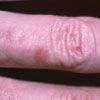
Figure 1
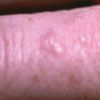
Figure 2
Case 2:
For several months, a 49-year-old woman has had blisters and fragile skin on the dorsa of her hands. She recently started hormone replacement therapy as well as naproxen for mild arthritis.
What do you suspect?
A.
Dyshidrotic hand eczema.
B.
Contact dermatitis.
C.
Photoallergic reaction to naproxen.
D.
Porphyria cutanea tarda (PCT).
E.
Pseudoporphyria induced by naproxen.
Which of the following has (have) been associated with the disorder seen here?
F.
Renal failure and dialysis.
G.
NSAIDs.
H.
Diuretics.
I.
Antibiotics.
J.
Cyclosporine.
(Answer on next page.)

Figure 1

Figure 2
Case 2: Pseudoporphyria
Pseudoporphyria, E, is characterized clinically by increased skin fragility, erythema, and the appearance of tense bullae and erosions on sun-exposed skin; these findings are identical to those seen in patients who have PCT. However, the hypertrichosis, hyperpigmentation, and sclerodermoid changes that are classically associated with PCT are unusual in patients who have pseudoporphyria.
Pseudoporphyria also mimics PCT histologically, but no porphyrin abnormalities are present. The precise pathophysiological mechanism of pseudoporphyria is not fully understood.
Numerous medications (including NSAIDs, G, diuretics, H, antibiotics, I, and cyclosporine, J), excessive UV-A exposure, and hemodialysis, F, can cause pseudoporphyria. Treatment consists of discontinuing the offending agent as well as avoiding excessive sun exposure.
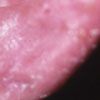
Case 3:
An otherwise healthy 56-year-old woman presents with a red, scaly, pruritic eruption on one ear. Another physician had prescribed desoximetasone cream and a tapering course of prednisone, but this regimen only temporarily relieved the patient's symptoms.
What is the likely cause of this eruption?
A.
Contact dermatitis to nickel.
B.
Atopic dermatitis.
C.
Seborrheic dermatitis.
D.
Relapsing polychondritis.
E.
Dermatophyte infection.
F.
Contact dermatitis to hair care products.
G.
Contact dermatitis to Bluetooth.
(Answer on next page.)

Case 3: Tinea of the ear
A markedly positive potassium hydroxide examination confirmed the diagnosis of dermatophyte infection, E. How she acquired the infection was unknown; no reasonable exposure history could be found.
Nickel contact dermatitis would affect only the earlobe. Atopic dermatitis would be bilateral. Seborrhea would also be bilateral, and it would be more likely to occur in the external auditory canal and behind the ear.
Relapsing polychondritis is tender and is not associated with scale. Contact dermatitis to hair care products usually occurs on the neck behind the ear. Contact dermatitis to Bluetooth would be confined to the location of the device and would not involve the entire external ear, as in this patient.
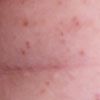
Figure 1
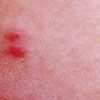
Figure 2
Case 4:
An otherwise healthy 25-year-old woman has had asymptomatic cysts on her trunk for several years. The disorder has been slowly progressive.
What is your clinical impression?
A.
Sebaceous cysts.
B.
Epidermoid cysts.
C.
Pilar cysts.
D.
Acne.
E.
Neurofibromatosis.
(Answer on next page.)

Figure 1

Figure 2
Case 4: Steatocystoma multiplex
A biopsy confirmed the clinical impression of steatocystoma multiplex, or true sebaceous cysts, A. This rare autosomal dominant disorder involves the pilosebaceous unit. The cysts first appear during adolescence or early adulthood; the disorder is lifelong. There is no effective treatment for this benign condition.
It would be unusual for epidermoid or pilar cysts to be as numerous as this patient's cysts were. Acne typically occurs in multiple stages (ie, pimples, comedones, and cysts). Neurofibromas are solid tumors that have a spongy feel.
References:
REFERENCE:
1.
Goette DK. Chilblains (perniosis).
J Am Acad Dermatol.
1990;23:257-262.
